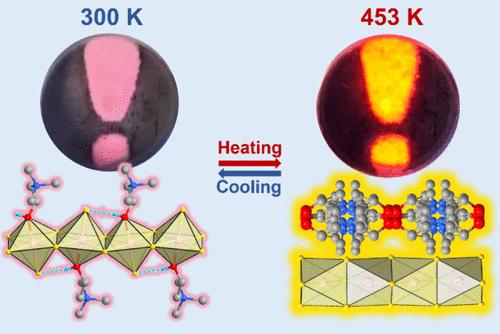重建相变使一维杂化钙钛矿的光致发光异常负猝灭
IF 4.7
2区 化学
Q1 CHEMISTRY, INORGANIC & NUCLEAR
引用次数: 0
摘要
有机-无机杂化钙钛矿(OIHPs)由于其结构的可调性和多种功能特性而引起了广泛的关注。在这类材料中很少发现涉及化学键断裂和重建的重建相变;然而,这些特性可能会在光学、铁电学、铁磁学等领域引发许多有趣的物理性质。在这里,我们利用HETMA- mncl3 (HETMA =(2-羟乙基)三甲基铵)的弱和可切换的配位键构建了一个具有中性框架的1D杂化钙钛矿。正如预期的那样,该化合物在421 K的高相变温度下经历了重构相变。HETMA-MnCl3具有显著的红色荧光、较宽的发射光谱和较长的发光寿命。令人印象深刻的是,HETMA-MnCl3的重建相变主导了负热猝灭和热猝灭行为的良好PL共存。据我们所知,这种现象在多功能光电材料领域很少发现。这项工作为探索具有重构相变的新型钙钛矿材料提供了可能性,并有助于进一步发展。本文章由计算机程序翻译,如有差异,请以英文原文为准。

Reconstructive Phase Transition Enables Abnormal Negative Thermal Quenching of Photoluminescence in a 1D Hybrid Perovskite
Organic–inorganic hybrid perovskites (OIHPs) have attracted enormous attention owing to their intriguing structural tunability and diverse functional properties. Reconstructive phase transitions, involving the breaking and reconstruction of chemical bonds, have rarely been found in such materials; however, these features may induce many intriguing physical properties in optics, ferroelectrics, ferromagnetics, and so forth. Here, we utilized the weak and switchable coordination bonds of HETMA-MnCl3 (HETMA = (2-hydroxyethyl) trimethylammonium) to construct a 1D hybrid perovskite employing a neutral framework. As expected, this compound undergoes a reconstructive phase transition with a high phase transition temperature of 421 K. HETMA-MnCl3 shows remarkable red fluorescence, a wide emission spectrum, and a long luminous lifetime. Impressively, the reconstructive phase transition of HETMA-MnCl3 dominates the excellent PL coexistence of negative thermal quenching and thermal quenching behavior. To the best of our knowledge, such a phenomenon has rarely been found in the realm of multifunctional optoelectronic materials. This work provides possibilities to explore new classes of perovskite materials with reconstructive phase transitions and contributes to further developments.
求助全文
通过发布文献求助,成功后即可免费获取论文全文。
去求助
来源期刊

Inorganic Chemistry
化学-无机化学与核化学
CiteScore
7.60
自引率
13.00%
发文量
1960
审稿时长
1.9 months
期刊介绍:
Inorganic Chemistry publishes fundamental studies in all phases of inorganic chemistry. Coverage includes experimental and theoretical reports on quantitative studies of structure and thermodynamics, kinetics, mechanisms of inorganic reactions, bioinorganic chemistry, and relevant aspects of organometallic chemistry, solid-state phenomena, and chemical bonding theory. Emphasis is placed on the synthesis, structure, thermodynamics, reactivity, spectroscopy, and bonding properties of significant new and known compounds.
 求助内容:
求助内容: 应助结果提醒方式:
应助结果提醒方式:


